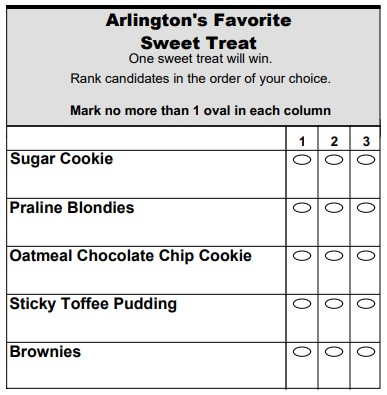Ranked Choice Voting
Ranked Choice Voting (RCV) - What is it? 
Ranked choice voting (RCV) is a voting method in which voters rank candidates in order of preference (1st choice, 2nd choice, 3rd choice). Ranked choice voting allows your vote to count towards another candidate if your 1st choice candidate receives the least amount of votes.
Arlington County implemented ranked choice voting for the first time in the June 20, 2023 Democratic Primary Election for the office of County Board (2 seats). It was approved for use in all future primaries for County Board on December 18, 2023. On February 24, 2024 the County Board approved the use of ranked choice voting in the November 5, 2024 General Election for the County Board race.
The video above was recorded before the 2024 County Board General Election.
How to Mark Your RCV Ballot
Voting a RCV ballot is very similar to voting a traditional ballot. With RCV, voters mark their ballots in order of preference - 1st, 2nd, and 3rd choice. Practice Marking a Ballot
How Your Vote Is Counted
All 1st choice votes are counted. If no candidates receive the required number of votes to win, the candidate with the fewest votes is eliminated and ballots for that candidate are transferred to the voter's next choice. This process continues until candidates have enough votes to win.
If your 1st choice candidate is eliminated, your vote is transferred to your 2nd choice candidate. If your 2nd choice candidate is eliminated, your vote is then transferred to your 3rd choice candidate.
Difference Between 1 and 2 Seat Elections
Arlington's County Board has 5 members. Members serve staggered 4-year terms. Each year, 1 member is up for election. Every fourth year, 2 members are up. In 2023, 2 seats were voted on. In 2024, 2025, and 2026, only 1 seat will be voted on. Tabulation varies slightly depending on the number of seats being voting on. In both types of election the number of votes needed to win is determined using the same formula. This formula accounts for the how many seats are on the ballot.
Formula to determine the number of votes needed to win: A candidate must receive the ((total number of ballots cast in the election) divided by the (number of seats + 1)) +1 to win.
When a single seat is open, this means that a candidate must receive more than 50% of the votes. (Total number of votes cast is divided by 2 (1 seat + 1) or 1/2 of the votes +1). Once a candidate receives 50% plus one of the votes, tabulation ends.
When 2 seats are open, a candidate must receive more than 33% of the vote. (Total number of votes cast is divided by 3 (2 seats + 1) or 1/3 of the votes + 1). Once a candidate reaches 33% plus one of the vote, tabulation continues to fill the 2nd seat. A fraction of votes cast for the 1st winning candidate are redistributed to the next choice on those ballots.
The regulation that discuss tabulations is Virginia Administrative Code 1VAC20-100-10.
Why is Arlington Implementing Ranked Choice Voting?
The Virginia General Assembly passed a bill to amend Code of Virginia § 24.2-673.1 in July 2020 to allow localities to implement ranked choice voting in elections of members of a county board of supervisors or a city council. In fall 2021, the Arlington Electoral Board conducted a public engagement with Q&A and a “mock election,” and held a joint work session with the County Board to discuss this method of voting in the County. In December 2022, the Arlington County Board adopted the use of ranked choice voting for the June 20, 2023 County Board primary election, making Arlington the first locality in Virginia to implement ranked choice voting. In December 2023, the County Board adopted the use of ranked choice voting for all future county board primaries.
Benefits of using RCV include:
- Ranking multiple candidates allows voters to still have a choice in who gets elected, even if their top choice does not win.
- Candidates have to appeal to people who might initially vote for someone else, improving civility in campaigns.
- Ensures candidates with the broadest support win the election.
Outreach & Education
Help educate our community about ranked choice voting,
Download Outreach Materials & Attend an Event
Stay Informed
Stay up to date with the latest Ranked Choice Voting information by subscribing to our newsletter.
Subscribe to our email newsletter!
FAQs
Is the voting process different with RCV?
Voting on a ranked choice ballot is a very similar process to voting on a traditional ballot. You will fill in the ovals on a paper ballot and then place your ballot into the ballot scanner to be counted. The only difference is you'll have the option to rank up to three candidates for the County Board race.
How many candidates can I rank?
You may rank up to 3 candidates in the County Board race.
Do the 3 candidates that I rank all get counted?
No. All 1st choice votes are counted in the initial round of tabulation. Your ballot will stay with your 1st choice until that candidates gets enough votes to win or is eliminated. Only then will your 2nd or 3rd choice vote come into play.
Do I need to rank all candidates?
No, you do not need to rank all candidates. You should rank at least one candidate as your 1st choice. If you do not rank any other candidates and your 1st choice candidate gets eliminated, your ballot will not count in any later rounds.
Are all offices going to be RCV style?
No. Ranked choice voting is currently only being used for the County Board race. Other offices will not be using ranked choice voting.